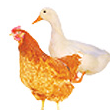Marek's disease is a highly contagious disease caused by Gallid herpesvirus 2 (GaHV-2) in chickens. Morbidity is 10-50% and mortality up to 100%. Quail and turkey are also infected with the disease. Other species of birds and mammals are not infected with Marek’s disease.
Epidemiology and transmission:
This is a highly contagious disease and spread rapidly among chickens. Mature virus can find in the follicle epithelium, from where they were released into the environment and infect via the respiratory tract. The viruses can survive in feces and litter for quite a long time (65 weeks). The infected chicken become virus carriers in a long time and is considered as the source of transmission. Chickens infected with Marek are more susceptible to other diseases, including diseases caused by parasites, coccidiosis and bacterial diseases.
Clinical signs
The disease causes many syndromes with various manifestations in neurological, visceral and cutaneous.
The clinical signs include:
Paralysis of legs, legs splayed out, one leg extended forward and one leg extended back. Wing and neck were also paralyzed.
Grey iris or irregular pupil.
Vision impairment.
Skin around feather follicles enlarged and roughened.
Loss of weight.
 |  |
Post-mortem lesions
Grey-white foci of neoplasia in liver, spleen, kidney, lung, gonads, heart, and skeletal muscle.
Thickening of nerve trunks and loss of striation.
Diagnosis
Based on clinical signs, lesions. Differentiate from deficiency of thiamine, deficiency of Ca, Phosphorus, Vitamin D, especially when chickens start to lay eggs.
Treatment
This is a disease caused by a virus so there is no specific medication.
Prevention
Apply all-in/all-out production
Clean up the tools after each flock is removed, really good chicken house disinfection is the safest method.
Routine disinfection the chicken house 1 time per week with disinfectants such as BIOXIDE, BIODINE ® or BIOSEPT.
When the weather changes should strengthen the resistance of chickens by vitamin C and electrolytes such as: BIO-VITAMIN C 10%, BIO VITA-ELECTROLYTES.

 Hotline:
Hotline:

.jpg?width=120&height=90&mode=pad&anchor=auto&scale=both)









Comments